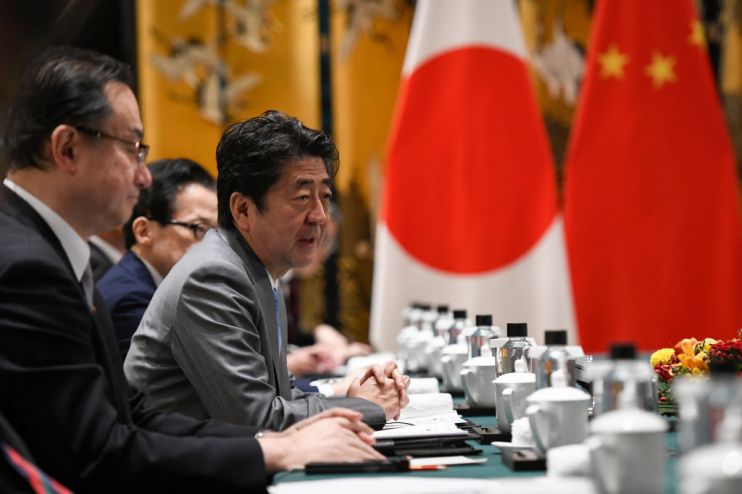A grown-up Japan marshals the world’s anti-China coalition

Intellectual coherence has its advantages.
While much of the western world has recently taken a holiday from history — as the US is weighed down by the melodrama of Donald Trump, the EU by the sleep-deprivation soap operas of its summit meetings, and the UK by profound confusions about how to respond to coronavirus — Japan has quietly behaved like a grown-up country, taking the lead against the increasingly aggressive Chinese foreign policy in Asia pursued by President Xi Jinping.
Japan’s success is only possible because we live in a new era of loose bipolarity where, beneath the dominant Sino-American conflict, great powers Russia, the EU, the Anglosphere countries, India and Japan have far more latitude to act independently in their own specific interests.
This structural reality has allowed Tokyo — in an almost wholly unremarked upon way — to take the lead in balancing Beijing in Asia, even in the face of a disastrous partial US disengagement.
Shinzo Abe, who has been Japan’s Prime Minister since December 2012, has stealthily put in place this wildly underreported Japanese foreign policy strategy, which has two distinct parts: geo-economics and geo-strategy.
In January 2017, largely for no other reason than his irrational hatred of his immediate predecessor, the new US President petulantly turned his back on the centrepiece of the Obama administration’s “pivot to Asia” — the Trans-Pacific Partnership (TPP), an ambitious free trade deal designed to link America far more economically closely to its allies along the Pacific rim.
The economic aspects of TPP were significant, but a primary purpose for the deal was unabashedly geopolitical. TPP would bind together the non-Chinese Asian world, establishing common trading norms around the US rather than Beijing.
In a disastrous act of foreign policy vandalism, Trump walked away from the TPP deal with 11 allied countries. In the old Cold War days of tight bipolarity, that would have been it; cowed by America’s disinterest, the allies would have dispiritedly abandoned the pact.
But, in this new era of loose bipolarity, instead something remarkable happened: the Abe government stepped into the void, shepherding a revised TPP to fruition.
The new version, now called the Comprehensive and Progressive Agreement for Trans-Pacific Partnership (CPTPP), became effective in December 2018. Filling the US void, Abe’s government hosted three of the four ministerial meetings that rescued the accord.
For countries such as Japan, Australia, Malaysia and Vietnam, the CPTPP remains largely a geo-economic measure designed to counter China’s economic dominance in Southeast Asia. Tokyo is keen to lock down the rest of Southeast Asia (Thailand, Taiwan, Indonesia, and the Philippines) as part of the CPTPP orbit.
In a further effort to blunt China’s key role in Japan’s own economy, on 17 July Abe delivered on previous promises to decrease Tokyo’s supply chain dependence on Beijing, rolling out a $653m subsidy for 87 major Japanese companies to move manufacturing out of China, diverting it to Vietnam, Malaysia and Japan itself.
Nor has the Abe government been shy about pointing the finger at Beijing as the great disruptor in Asia. In a just released 14 July Defence White Paper, the Japanese government forthrightly singled out China as the main threat to its security.
As such, Abe has also designed a geostrategic initiative, matching the CPTPP in balancing a rising China: the Quadrilateral Security Dialogue, or “the Quad”.
First established during Abe’s brief earlier stint as Prime Minister in 2006-07, the Quad — composed of key regional powers Japan, the US, Australia, and India — initially fell apart due to China’s diplomatic pressure on Australia and India. However, Abe has managed to resurrect this nascent grouping, which in the future could serve as the basis for a more formal alliance of democratic Asian states determined to balance Beijing.
While it is true that Quad members are not yet united in viewing the grouping as anything like a formal alliance directed against Beijing (India has been particularly hesitant, given its non-aligned history), events are moving in the Quad’s direction.
Following recent Sino-Indian clashes in the Himalayas, Beijing’s bullying of Australia over its calls for an investigation into the origins of Covid-19, and growing Sino-American strategic tensions, it may well be that the Quad’s time is coming.
When the history books of our time are written, Abe’s quiet but effective diplomacy in salvaging the CPTPP and establishing the Quad will deserve to get far more attention than reckless Trump or feckless Europe, despite all the noise both are presently generating. For ultimately, it pays to be a grown-up.
Main image credit: Getty